80 Microcomputing
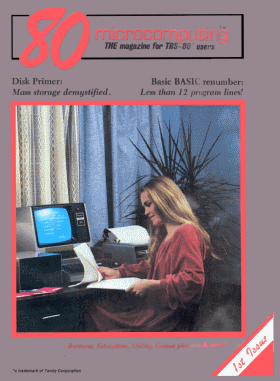
January 1980 issue of 80 Microcomputing
80 Microcomputing, also known as 80 Micro, was the most famous of the TRS-80 magazines and the best remembered. It was the first of the platform-specific computer magazines to become very popular, creating a model that many other magazines followed. Harry McCracken, former editor-in-chief of PC World, described PC World as “essentially an 80 Micro clone that happened to be about Windows, not TRS-80’s.”
80 Microcomputing published for 101 issues from January 1980 to June 1988, plus one special anniversary issue in 1983. With the combined June/July 1982 issue, 80 Microcomputing was renamed to 80 Micro and the cover date was advanced one month.
The magazine was very successful and spawned:
- a spinoff magazine for the Color Computer (Hot CoCo)
- a spinoff magazine for MS-DOS (PC Resource)
- a ten-volume series of books (The Encyclopedia of the TRS-80)
- a book of extra material (The Rest of 80)
- a book of reviews (80 Micro’s Review Guide)
- a monthly collection of programs supplied on tape and disk (LOAD-80)
Origins
80 Microcomputing was created by Wayne Green, the founder of many magazines including 73 and Kilobaud Microcomputing (of which 80 Microcomputing was a spinoff). Wayne Green envisioned 80 Microcomputing as being about the readers and included this appeal in the first issue under the heading “You are the Author”:
All of my magazines have one thing in common—they are written entirely by the readers, you. If you buy something which should be written about, write about it.
If you get some software which is great, write about it. If it is awful, say so. Try to think of 80 Microcomputing as more of an enormous and informal club newsletter than a pontificating magazine.
This formula seemed to work. The magazine took off and soon each issue was packed with articles, reviews, and columns, most written by the readers. At its height in 1982, 80 Microcomputing was the third largest magazine in the country. Only Vogue and BYTE were larger. The largest regular issue published was November 1982 at 518 pages. The special Anniversary issue published a few months later was even larger at 594 pages. Since the ratio of editorial pages to advertising pages remained roughly equal, these issues contained around 250 pages of advertising. This abundance of advertising demonstrated the vibrancy of the TRS-80 market and many of those advertisements remain interesting today.
On May 22, 1983, Wayne Green signed an agreement to sell 80 Micro and most of his other magazines to CW Communications, the publishers of computer magazines such as Computerworld, InfoWorld, and PC World. The November 1983 issue was the first published by CW Communications and Wayne Green’s “Remarks” column disappeared from the magazine.
The sale to CW Communications marked a change in focus for 80 Micro. The magazine gradually moved away from articles and columns written by readers in favor of those written by staff writers. User submitted reviews were no longer accepted. One of the immediate changes was a sharp increase in advertising rates. This led to many smaller companies reducing or cancelling their advertisements. Partly as a result, the size of 80 Micro shrank in half within a year.
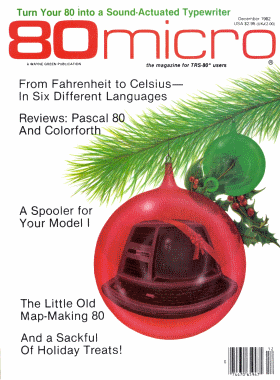
December 1982 issue of 80 Micro
Coverage
80 Microcomputing originally focused only on the original TRS-80 (the Model I), but expanded its coverage to include additional Radio Shack computer models as they were introduced. In all, the magazine covered (although not all at the same time) the Model I/III/4, Model 100, Color Computer 1/2, Model II/12/16, Model 2000, and the Tandy MS-DOS computers such as the Model 1000 series.
Starting in August 1983, the Color Computer content was moved to the recently spun off Hot CoCo magazine. Coverage of the Model II/12/16 quietly disappeared at about the same time. After Hot CoCo stopped publishing with the February 1986 issue, some of the Color Computer features moved to 80 Micro in the March 1986 issue. Those features remained until December of the same year.
Over its long run, 80 Microcomputing contained many well remembered columns including:
- “80 Applications” by Dennis Báthory-Kitsz
- “News From Kitchen Table Software, Inc.” by David Busch
- “The Assembly Line” by William Barden
- “The Next Step” by Hardin Brothers
- “Fun House” by Richard Ramella
- “Feedback Loop” by Terry Kepner
- “The Gamer’s Cafe” by “Rodney Gambicus”
- “Commander 80” by Jake Commander
- “80 Remarks” by Wayne Green
The End
In November 1987, it was announced that 80 Micro would cease coverage of TRS-80 computers with the December 1987 issue. Beginning with the January 1988 issue, the magazine would focus exclusively on the Tandy MS-DOS computers. There were a number of reasons given for the decision, but many loyal readers (some of whom had been subscribers from the first issue) complained of feeling as though they were being discarded. The end of the TRS-80 coverage in 80 Micro led directly to the creation of three other TRS-80 publications: TRSTimes, Computer News 80, and TRSLINK
With no more TRS-80 coverage in 80 Micro, many TRS-80 companies stopped advertising. Without MS-DOS companies to replace them, the magazine soon dropped by 40 pages. With declining subscriber numbers, diminished advertising, and very narrow focus, it was sad but no surprise when 80 Micro published its final issue in June 1988. That final issue was only 80 pages long.
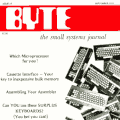
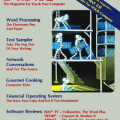
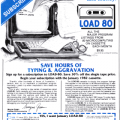
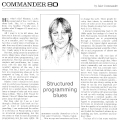










Ivan R Kennedy says:
Happy to see the coverage of 80 Micro. I waited for each issue in great anticipation and do retain almost a complete set of the magazine, lacking only #1 and #10.
It’s a shame Charles Tandy hadn’t lived longer and the TRS-80 line might have developed independently; Bill Gates would have had more competition.
When I partly retire in a year or two, I intend to spend far more time with 80 Micro, stoking up memories of the days when we actually participated in computer developments, both hardware and software and weren’t more or less restricted just to what Bill Gates and others serve up.
Thanks for your wonderful work on this.
Michael M. T. Henderson says:
My very first computer was a TRS-80 Model 1, purchased in 1978, which used cassette tapes for storage of programs and data. Eventually I got an “Expansion Interface,” which contained 2 5.25" floppy drives–single-sided-single density, holding about 160K each. That was great compared to the tapes. In 1980 or so I got my first hard drive, a 15mb behemoth the size of a shoebox. I still had to boot from a floppy in order to load TRSDOS, the operating system, but after that it was very fast. I skipped the 16-bit Model 2 (as most people did) and the one-piece Model 3, with 2 floppy drives built in. In 1982 I moved, with some nostalgic regret, into the DOS 3.2 world with my first IBM compatible computer, a Leading Edge machine with 640K RAM and a 30MB hard drive from which it could boot directly to the C: prompt relatively quickly. Now I’m on my fifth computer, an HP with 4g of RAM and a 500GB hard drive. It came with Vista, and I now have Win 7 on it.
There are things I miss about the C: prompt and Config.sys and Autoexec, because I could easily write programs in QuickBasic or Access Basic, but in general I like Win 7. It’s nice not to have to remember the difference between extended and expanded RAM, and to get away from the IDE disk connection system–even if 7 takes 5 minutes to boot.
Bob Liddil (AKA Captain 80) says:
Like so many other TRS-80 users of the time, I loved 80 Micro.
I had the honor and rare treat of also being able to write articles and a column for my favorite magazine, as well as knowing many of the editors and other writers personally.
That was a wonderful time to be young and technically alert.
What an adventure!
Jim Perry says:
As the “founding” editor of 80 Micro, then to depart to IJG & Exatron. last saw Bob in London about 30 years ago! Funny old world.
William C. Garretson says:
I was always a big fan of 80 Micro, although I didn’t get into computing until late 1983. I was even one of the contributing authors (“Fireworks Factory”, July 1986).
I have owned as many as three TRS-80 Color Computers (Two 2’s and a 3), but they’ve conked out one by one over the years.
Funny how, even though computers keep getting faster and faster, the operating systems and other software that run on them seem to get slower and slower! I’m afraid programmers by and large are just getting lazier. Furthermore, I believe that many so-called obsolete computers never really reached their full potential.
Although I eventually branched out into MS-DOS computers and then Windows and Web-based work, I still miss the CoCo!
Pete Olivier says:
I remember 80 Microcomputing with fondness. I live in the Linux O/S these days, and would love to be able to refer to some of the old program listings and articles – things like “Gabby Coot” (a colorful character monologue genrator) and the “Kitchen Table” articles. Alas, my collection was pulped in the flooding of New Orleans following Hurricane Katrina.
Gone, but not forgotten…
DeWitt Shank says:
I’d like to call attention to two of the most useful TRS-80 BASIC programming books ever written, both by an ingenious programmer Lewis Rosenfelder. The first is Basic Faster and Better & Other Mysteries. The second is Basic Disk I/O Faster and Better & Other Mysteries.
Mr. Rosenfelder took interpreted BASIC to a whole other level of functionality. He claims to have only spent 3 years learning the content he put in these 400-some page books. Unbelieveable!
I had the good fortune of communicating with him very briefly by email a few years ago. What a guy! Thanks, Mr. R., for all your fantastic help.
Roger Smith says:
Oh, this brings back memories … :-)
I wrote several articles for 80 Micro including the series “Bugs from Outer Space” describing how to write an arcade game in assembly language.
It was an exciting time.
Back in those days I knew the TRS-80 inside and out. I knew everything about the computer from how information was stored on the Model III’s floppy drives to what each indvidual part did on the motherboard. I could write code in machine language – for example, typing in the hex values 21 00 3C 11 01 3C 36 20 01 00 04 ED B0 (I still recall that sequence) to clear the screen. I often resorted to hand-assembled machine code to overcome the memory limits. My first TRS-80 only had 1K of free memory. When I upgraded it to 4K of total memory, tripiling the available memory to 3K, I was certain I would never find a way to use all of that memory!
Peter Hammer says:
In 7th grade, my Dad showed up one day with a TRS-80 Level 1 computer and said “this will change your life.” Was he right! I loved 80 Micro and couldn’t wait for the next issue to arrive! What an adventure is right.
In one issue was an article about drawing a line faster in assembly language. I studied it over and over and used it as inspiration to learn Z80 assembly language and create my own library of graphics routines. Does anyone happen to know how to get a copy of it or even in which issue it was? It would be a fun walk down memory lane of a very exciting time. Many thanks in advance.
Dave Whitmore says:
The LNW 80 was my first computer, built from a kit in 1978. I was putting 50 cent chips into $2 gold plated sockets; and had to wire the keyboard too. It had two monitors, one B&W (for “high res” graphics and writing code) and one Colour for medium res colour graphics. {both made from old TVs}
I used to buy every copy of Byte and 80 MicroComputing (later 80 Micro) because I could get honest reviews and also program listings submitted by users and others. ‘Off the Shelf’ software was rare and could not be modified for my LNW graphics or other features added.
It was the days when computer hobbyists and tinkerers were the main people buying computers; though many business types realized their potential too.
Now, people buy computers to play violent games or download porn off the net. They have no idea how the machine works, and often can’t even tell where the computer ends and the internet begins. Nor do they care. Evolution, I guess.
Though I do appreciate speedy Hard drives and 32 bit colour graphics with transparency vs. 8 colour low res screens; I do miss the challenge and rewards of creating my own programs and wiring my own hardware; it was a very different world then, and I miss it. ~Dave \W/
Al Hartman says:
My very first computer was a TRS‑80 Model 1, purchased in 1979. I had seen one the year before at a Star Trek Convention in NYC and knew I wanted one. I’d spend long hours typing in programs from every much anticipated issue of 80-Micro, and David Ahl’s books. I got so good with it, my local Radio Shack hired me.
Eventually I bought an Expansion Interface, which I populated with 32k of RAM I bought from an 80-Microcomputing advertiser (MUCH cheaper than the Radio Shack price, even with my employee discount.) I bought it on lay-away, and the night before I made the last payment, I took it home, added the 32k memory, tested it, and brought it back to the store. Only to pay it off and take it back home again. I’m the only person I know who voided his warranty before it became valid.
My first disk drive, which I also bought from an 80-Micro advertiser was junk. It was an MPI drive that never worked right. My second drive was a Wangtek Flippy drive I paid $321 for. I later added two more drives which were various different brands (a pair of bargain BASF drives were the worst!)
I bought a Percom Doubler and added that. Later, an RS-232 Board and a surplus 300 baud acoustic coupler modem. I had to manually dial and hit an on-line switch while quickly putting the handset on the coupler.
I bought an Okidata Microline-80 Printer, and was able to print things from programs I typed in. I installed the Electric Pencil Lowercase mod on my system.
I loved 80-Micro, and also BYTE. I later got an IBM XT Clone, a Coco, and Atari 400, Atari-ST, an Amiga, a ZX-Spectrum, and all sorts of other systems.
I still have my Model I which no longer works sadly. I bought an LNW-80 Model I a few years ago on eBay. I had several Model 4P computers I sold off (never liked the small screen). I recently got a Model I keyboard unit, a Model 4D and a Model III at a swapmeet.
I use Windows PCs now, but they are nothing like the fun I had in the early 80’s with my Model 1.
Someday, I hope to revive it.
Randal Lanning says:
I bought my TRS-80 Model I level I with 4k of memory in 1977. Within a year I sent it in to have it upgraded to Level II and 16k. During that time, I taught myself BASIC, Pascal, and assembly. I can still remember the op codes and mnemonics.
When I discovered 80-Micro I pretty much bought one every month at the local book store. I keyed in so many things and made several saves to cassette before turning off the machine for fear of having to retype it all.
Those were the days when modifying (I ended up adding my own memory and so-forth later as I got bold enough to open the cover) and programming were a lot of fun. It still is to me but nothing like those days when every byte counted.
Don Kleppinger says:
My first computer was a TRS-80 Model 1 I got when I was a senior in high school. During college I modified it to show lowercase letters and used for one of my electronics projects. After college I worked for Apparat Personal Computers, maker of NewDos/80. I loved 80 microcomputing and Apparat advertised in it quite a bit. I worked on designing and building expansion boards for the TRS-80 and then the early IBM PC’s. I worked there for 5 years before the company closed unable to compete with the cheap “made in Taiwan” imports. Brings back memories
Raymond Day says:
I remember this magazine I still have all that I got up in the attic. I did look though some a few years ago and it was neat to see the old things in them.
-Raymond Day
Laser TSV says:
Does anyone remember if there was a games issue of 80 Micro Magazine that came with either a floppy or cassette tape? I remember loading some games on my Model 3 in the 1980’s and I am trying to remember where they came from. I remember there was a text only flight simulator that I was never able to successfully land. There was also a CIA or FBI text adventure game that I could never figure out. It came with printed picture to examine, and I remember you could send out agents to investigate the various clues you found. I’ve always wanted to track down these obscure games.
Cord Coslor says:
Harry McCracken, who was referenced in this article as the former Editor-in-Chief of PC World magazine, was quite the TRS-80 programming prodigy himself! As a matter of fact, I believe I first became aware of Harry was from an article that Bob Liddil wrote… Bob wrote for 80 Micro, 80-US Journal (Captain 80…), etc. Bob has since passed away, but it sure was cool seeing/hearing his voice in the comments above.